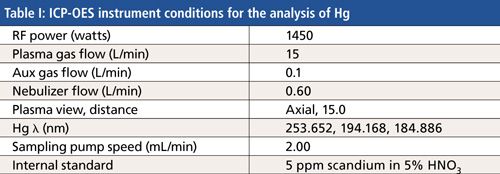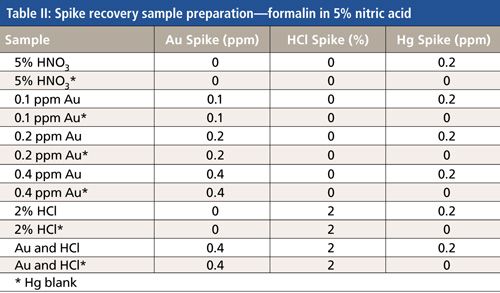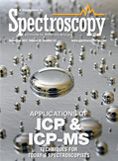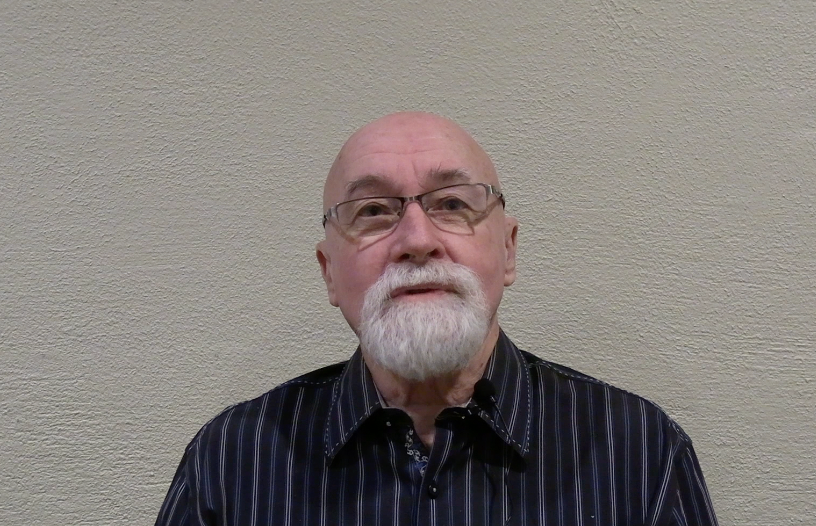Sample Preparation Method for Mercury Analysis in Reagent Chemicals by ICP-OES
Special Issues
Efficient and accurate measurement of mercury concentration is a challenge. A direct sample preparation method for reliable ICP-OES mercury measurement would be invaluable to chemical manufacturers, testing laboratories, and other industries. Historically, ICP-OES Hg measurements have been plagued by poor Hg detection limits, severe carryover effects, and sample instability. In this study, we present a method of sample preparation for ICP-OES mercury analysis in various reagent chemical compounds. This sample preparation method is straightforward and direct, allowing mercury analysis in a variety of reagent chemicals without digestion.
Efficient and accurate measurement of mercury concentration is a challenge. A direct sample preparation method for reliable inductively coupled plasma-optical emission spectrometry (ICP-OES) mercury measurement would be invaluable to chemical manufacturers, testing laboratories, and other industries. Historically, ICP-OES mercury measurements have been plagued by poor mercury detection limits, severe carryover effects, and sample instability. In this study, we present a method of sample preparation for ICP-OES mercury analysis in various reagent chemical compounds. This sample preparation method is straightforward and direct, allowing mercury analysis in a variety of reagent chemicals without digestion.
Mercury (Hg) exists naturally in the earth’s crust, with an average abundance of about 0.08 ppm by mass (1). Hg can be found in many sources, including wastewater, seafood, and the emissions from burning coal. Although the ancient Chinese thought mercury maintained good health, in modern society mercury is considered harmful and an environmental pollutant. Analytical techniques for mercury analysis include several atomic spectroscopic techniques: cold vapor atomic absorption spectroscopy (CVAAS), cold vapor atomic fluorescence spectroscopy (CVAFS), inductively coupled plasma-optical emission spectrometry (ICP-OES), inductively coupled plasma-mass spectrometry (ICP-MS), and direct analysis by thermal decomposition. The preferred analytical technique often depends on the regulations with which different laboratories are required to be in compliance. Most United States Environmental Protection Agency (US EPA) methods, such as EPA 245.1, EPA 245.2, EPA 1631E, EPA 7470A, and EPA 7471B, require the use of CVAAS or CVAFS. In EPA Method 200.8 and Method 6020A, Hg analysis is performed using ICP-MS. Some instrument manufacturers claim that CVAA and CVAF with detection limits of ~2 ppt (parts per trillion) and ~0.2 ppt, respectively, are preferred for Hg analysis. However, a direct and reliable ICP-OES (detection limit of ~20 ppb) mercury measurement method would be invaluable to laboratories. ICP-OES elemental determination is fast and accurate, and has good tolerance for high organic content and total dissolved solids (TDS). ICP-OES can also provide simultaneous multiple element quantification in samples that other techniques cannot.
In this study, we propose a reliable and straightforward sample preparation method for measuring mercury in reagent chemicals using ICP-OES, derived from generally accepted methods developed for ICP-MS analyses. This work is an extension of previous studies done in our laboratory to conduct quality control of certified reference materials (CRM) Hg in aqueous solutions. A series of analyses was performed to determine an ideal sample matrix preparation for stability and analysis of lower concentrations Hg in CRM solutions. Samples prepared with Au3+ and hydrochloric acid (HCl) (2) were determined to have the most stable and reliable Hg results. The Au3+ and HCl ICP-MS preparation method eliminated the memory effect of Hg, increased sample stability over extended time, and reduced instrument relative standard deviation (RSD) (2). This study is in agreement with an EPA fact sheet for preserving and analyzing samples with Au3+ and HCl specifically in regards to Hg analysis (3). Using this sample preparation method, we analyzed Hg spike recovery in various reagent chemicals, including organic compounds and salts by ICP-OES. Previously, more complicated sample treatments, such as microwave digestion (4,5), have been required to analyze such samples. In this study, we show that a direct Au3+and HCl sample preparation method quickly and simply allows for accurate Hg ICP-OES quantification in a wide range of sample types.
Experimental
The ability to accurately analyze Hg via ICP-OES was verified by using Hg spike recovery. Spike recovery is achieved by the addition of a known amount of an element or analyte to a sample and comparing that known value with the analytical results. The equation for percent spike recovery is calculated as shown in equation 1:

Here, Cs = Hg concentration of the spiked sample, Ct = Hg concentration of the blank target sample, and Ck = known spike concentration. Spike recoveries of ~85-115% are considered acceptable.
All analyses were performed on a PerkinElmer Optima 7300 DV ICP-OES system. The sample introduction system was equipped with a Meinhard nebulizer and a cyclonic spray chamber. The ICP-OES method conditions for the analysis of Hg, and other heavy metals, are summarized in Table I. The ICP-OES system has an instrument detection limit (IDL) of ~0.005 ppm for Hg. This is a statistical reading of the instrument obtained from an analysis of 10 replicates of a 5% HNO3 blank. A two-point instrument calibration curve was made with a blank sample and a 0.2 ppm National Institute of Standards and Technology (NIST) Hg standard reference material (SRM), also spiked with Au and HCl. Between each sample run, five blanks of 5% HNO3 solution were run to prevent carbon build-up on the torch. After analysis, percent spike recovery and percent instrument RSD were calculated.

Formalin (HCHO) (ACS reagent grade, Spectrum) was chosen to investigate optimal sample preparation conditions for Hg analysis. We speculated that formalin’s property as a strong organic reducer makes Hg quantification very difficult. The formalin sample was prepared initially by dissolving 4 g of HCHO in 200 mL of 5% HNO3 (J.T. Baker, 9598-34). Different amounts of Au3+ or HCl were added to the formalin samples to test their effect on Hg spike recovery. Spiked samples and blanks for the various methods examined were prepared as detailed in Table II. Percent Hg spike recovery, as well as instrument RSD was calculated for each preparation method in Table III.


The Au3+ and HCl (0.4 ppm Au + 2% HCl) spike method was chosen and applied to several reagent chemicals (ACS grade, Spectrum) for sample preparation. These reagent chemical samples were prepared by dissolving 2 g of the chemical in 100 mL of 5% HNO3. Spiked reagent chemical samples and blanks, with and without Au3+ and HCl spiking, were prepared as in Table IV. Two sets of mercury-spiked samples were prepared for analysis. The first set of samples in 5% HNO3 was spiked with 0.2 ppm Hg (SPEX, PLHG2-1Y). The second set of samples in 5% HNO3 spiked with 0.2 ppm Hg was also spiked with Au3+ (SPEX, PLAU3-2Y) and 2% HCl (J.T. Baker, 9530-33). The Hg spike recoveries for these reagent chemicals used are listed in Table V.

Results
The results for Hg spike recovery in formalin are presented in Table III. Measurements of each sample preparation method were first done <8 h after initial preparation, then 72 h and 96 h later. The initial Hg spike recovery for the formalin sample in only 5% nitric acid was 125.4% (above the 115% limit for an acceptable recovery). This exaggerated recovery indicated artificially high mercury levels resulting from an incompatibility between Hg and the sample matrix. Subsequent measurements showed even higher artificial levels of mercury (>600%). Those results were determined to be unreliable for accurate Hg analysis. The formalin samples spiked with 0.2 ppm Hg, which were also spiked with either Au3+ or HCl showed recoveries close to, but often above, the 115% control limit. Instrument RSD were acceptable, <3%. The formalin sample spiked with 0.2 ppm Hg and also spiked with both 0.4 ppm Au3+ and 2% HCl showed recovery within control limits (93%) and RSD <2%.
The results of ICP-OES Hg spike recovery analysis for other reagent chemicals are shown in Table V. Several of the reagent chemicals investigated required only dissolution in 5% nitric acid to achieve acceptable Hg spike recovery: ammonium sulfate, potassium iodate, and sodium acetate. For the remaining reagent chemicals investigated in this study, Hg spike recovery of the sample in 5% nitric acid is far outside the 85-115% control limits. However, if spiked with 0.4 ppm Au3+ and 2% HCl, all reagents chemicals reported Hg spike recovery within control limits.
Discussion
The goal of this work is to extend direct mercury ICP-OES quality control analysis to a broader range of possible samples, including those with high organic and TDS concentrations. For these samples, understanding matrix-analyte interaction is a vital factor in successful sample preparation and sample measurement. Formalin was chosen as an example for its high organic content and reductive property. Reduction of mercury from Hg-2 to Hg-1 or Hg0 leads to instability of Hg in solution, causing inaccurate ICP-OES measurements. Reduced Hg has a higher propensity for sublimation from the nebulizer stream causing Hg memory effects in the torch. Particles of metallic Hg entering the plasma can lead to erroneously high reported values, also affecting instrument RSD.
Results of the formalin experiments demonstrate that both Au3+ and HCl contribute to the increased Hg stability in solution, leading to Hg ICP-OES measurements close to acceptable limits. Samples prepared with only 5% HNO3 are clearly unstable over time. When measured less than 8 h after Hg spike, the recovery percentage is above the control limit, while after several days the measurement is completely unreliable. Samples spiked with Au3+ exhibited much higher Hg stability than without. Note that the gold is added as gold(III) chloride, which contributed trace amounts of HCl, <0.001%, to the sample. Gold concentrations from 0.1 ppm to 0.4 ppm were tested and found to have consistent results. Samples that were spiked with 2% HCl exhibited similar Hg stabilization effects, while samples spiked with 0.4 ppm Au3+ and 2% HCl showed promising results. This combination resulted in a better Hg recovery, ~93%. Because the combination of 0.4 ppm Au3+ and 2% HCl resulted in recovery within control, the Au3+ and HCl method was applied to a broader range of chemicals, including organic compounds and salt samples. Only a few reagent chemicals resulted in successful Hg spike recovery without the Au3+ and HCl addition. The samples with the addition of Au3+ and HCl tested were all well within control limits with good recoveries.
Reasonable assumptions about mechanism of the stabilizing effect of Au and HCl on Hg measurements can be made. In this particular work, the carryover effects are of minimal concern because of the low absolute concentration of the Hg involved, and the need for extended flushing between samples to prevent organic or salt build up. It is believed that the major hindrance for Hg measurement in ICP-OES is the reduction of mercury in solution. For example, reported recovery of Hg in formalin becomes completely unreliable over time, more so than other reagent salts tested. This can be attributed to the reduction of Hg2+ to Hg0 in the formalin matrix. The inclusion of Au3+ or HCl can therefore make the reduction of Hg2+ unfavorable. Evidence for this can be explicitly shown by comparing the redox potentials of Hg in the presence of Au3+ or HCl. The addition of gold (as AuCl4-) can lead to competition between Hg2+ and Au3+ reduction reactions. Comparing the standard reduction potentials for mercury (equation 2) and gold (equation 3), we see that the Au3+ reduction will be more favorable:


Mercury exists as tetrachloro-mercurate(II) in solution in the presence of sufficient HCl concentration to provide chloride ligand and HNO3. The reduction potential for this species (equation 4) is lower than that of mercury alone (equation 2), slowing the rate of Hg0 creation:

The effects of gold and HCl are complimentary, indicating that the combination of Au3+ spiking and sufficient HCl concentration will lead to better results. Both gold and HCl are required to achieve sufficient precision for quality control of CRM solutions.
The main challenge in direct, accurate Hg analysis in reagent chemicals is accounting for interactions between the sample matrix and the analytes to be measured. These interactions can be difficult to predict and overcome. In the examples investigated in this study, some reagent chemicals act to stabilize Hg measurements themselves, while others lead to very unstable readings. Determining the behavior of mercury in a given reagent matrix is not generally possible a priori, so a direct, reliable method of Hg that can be applied to any reagent chemical would be very useful. Other methods of sample preparation involve decomposing the initial compound, such as microwave digestion or conventional digestion with acids or acidic conditions. These methods are time consuming, difficult to perform, and introduce many new variables to the analysis conditions.
We advocate an Au3+ and HCl preparation method to investigate various reagent chemicals. The Au3+ and HCl method in this study resulted in Hg recovery results well within control requirements for all the high organic and high TDS solutions tested. The preparation method was simple to perform, and allowed samples to be directly measured the same day as prepared and to also be stable over several days. While useful for mercury ICP-OES analysis, the Au3+ and HCl method does have sample and matrix interactions that must be taken into consideration for each case in which it is used. To confirm the proper sample preparation techniques have been used to test for Hg contamination, a spike recovery experiment is a helpful tool.
Conclusion
The EPA fact sheet for Hg stabilization (3) can be extended to ICP-OES analysis of mercury. The addition of Au3+ and HCl allows for accurate, quantifiable, and direct analysis of Hg without special sample treatment. The method developed here can easily be applied to samples containing high organic or TDS content. This allows for the direct analysis of reagent chemicals and other raw materials. While the Au3+ and HCl preparation method is a potentially powerful tool for Hg measurements, sample-matrix effects must always be taken into account.
References
(1) H.L. Ehrlich and D.K. Newman, Geomicrobiology (CRC Press, Boca Raton, Florida, 2008), pp. 265.
(2) B. Driscoll, SPEX CertiPrep, “Ask a Chemist,” available at: http://www.spexcertiprep.com/knowledge-base/ask-a-chemist.aspx (accessed March 15, 2015).
(3) L.C. Butler and J. G. Pearson, “Mercury Preservation Techniques” (U.S. Environmental Protection Agency, Washington, D.C., updated March 2003).
(4) U.S. EPA. Method 6020A, Revision 1, “Inductively Coupled Plasma-Mass Spectrometry” (U.S. Environmental Protection Agency, Washington, D.C., 2007).
(5) J.T. Creed, C.A. Brockhoff, and T.D. Martin, U.S. EPA. Method 200.8, Revision 5.4, “Determination of Trace Elements in Waters and Wastes by Inductively Coupled Plasma-Mass Spectrometry” (U.S. Environmental Protection Agency, Washington, D.C., 1994).
Yogesh Parikh, Samantha Mahmoud, James Lallo, and Huifang Lang are with SPEX CertiPrep in Metuchen, New Jersey. Direct correspondence to: hlang@spex.com

How Do We Improve Elemental Impurity Analysis in Pharmaceutical Quality Control?
May 16th 2025In this final part of our conversation with Harrington and Seibert, they discuss the main challenges that they encountered in their study and how we can improve elemental impurity analysis in pharmaceutical quality control.
High-Speed Laser MS for Precise, Prep-Free Environmental Particle Tracking
April 21st 2025Scientists at Oak Ridge National Laboratory have demonstrated that a fast, laser-based mass spectrometry method—LA-ICP-TOF-MS—can accurately detect and identify airborne environmental particles, including toxic metal particles like ruthenium, without the need for complex sample preparation. The work offers a breakthrough in rapid, high-resolution analysis of environmental pollutants.

.png&w=3840&q=75)

.png&w=3840&q=75)



.png&w=3840&q=75)



.png&w=3840&q=75)






